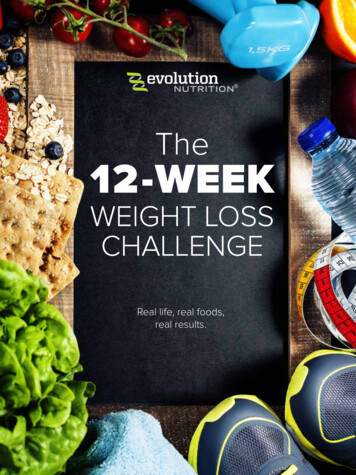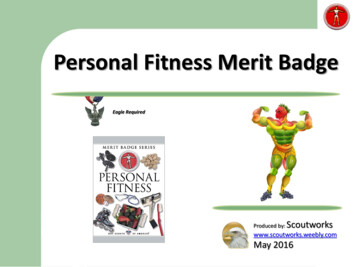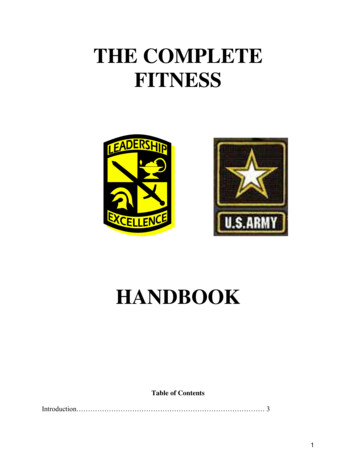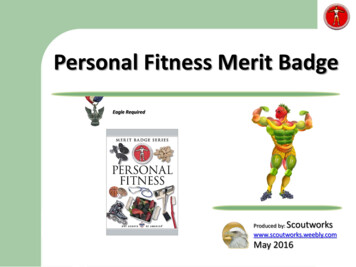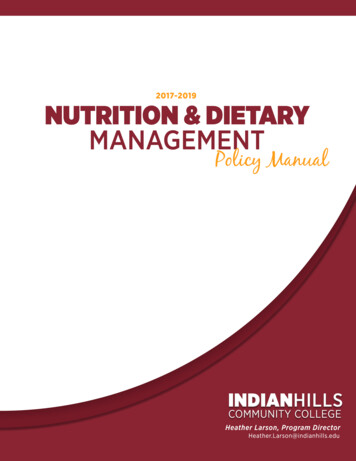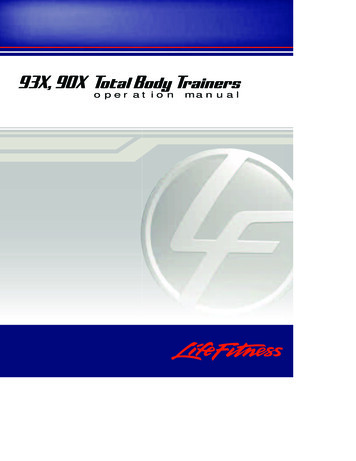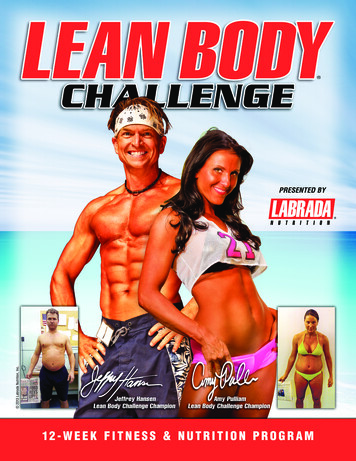
Transcription
2013 Labrada Nutrition, Inc.PRESENTED BY12 - W E E K F I T N E S S & N U T R I T I O N P R O G R A M
Welcome to the Lean Body Challenge Program!This is an easy to follow, step-by-step plan that will help you get into the best shape of your life.If you’re frustrated with diets and gimmicky exercise programs, here’s your chance to try somethingthat really works.I can and want to help you get into shape! Since I created it in 2013, the Lean Body Challengehas helped literally thousands of people all over the world to get into the best shape of theirlives. Now I’d like to share it with you.The key to your success with this program is to make healthy lifestyle changes in small steps toachieve the end result you’ve envisioned. I recommend that you do this by eating 5 smallfrequent meals throughout the day and that you integrate a combination of cardiovascular andresistance training into your program. The important thing is that you enjoy the activities andchanges so you’ll stick with them in the long run.There are two main reasons that people fail in their plans to get into shape.Reason one: People simply start out with the wrong information.Reason two: People lose motivation.LEE LABRADAFormer Mr. Universe22 MajorBodybuilding TitlesIFBB Hall of FameInductee.and now, he’s your 2013 Labrada Nutrition, Inc.Lean BodyCoachOnce you have the right program and the right tools to help you stay motivated, the “get inshape” equation is completed, and you can achieve your body shaping goals. Mind you, it won’thappen without work, but if you have the right map and you are motivated to follow it throughto its finish, YOU CAN get into great shape.Now, I want you to listen to this carefully No matter what shape you are in now, you CAN improve your body, and by extension, your selfimage! And in many cases, you can improve so much that your family and friends won’t believeyour transformation.This program works for the following reasons: It stimulates your metabolism while you reduce body fat. You don’t have to go hungry while on this program.Before you get started, I recommend that you do the following: Take a “before” picture. This will demonstrate where you are at the beginning of your journeyto obtain a more lean and healthy body. (Take one of the front, one of the back and one to theside. It also helps if you take your before pictures in a swimsuit so you can really see your progresswhen you take your “after” pictures at the end of the 12-week program.) Set realistic, but specific goals for the 12 weeks. Determine how you want to measure your personal success and stick with this system for theduration of the 12 weeks (i.e., dropping weight on the scale, losing dress or clothes sizes, losinginches on your tape measurements, or reducing body fat percentage by using fat calipers).The Lean Body Challenge program is designed to be a 12-week program. You will definitely seepositive results within that timeframe if you stick with your program. Once you finish the 12weeks and account for your success, you can keep the program going until you reach your goals.At that point, the program becomes a long-term maintenance program to keep you in shape foryears to come. Remember – the goal isn’t to get in shape just once.but to change your lifestyle.
One thing to keep in mind before you begin: I recommend that you eat about 5 – 6 small mealseach day. This will consist of three main meals: a breakfast, lunch, and dinner, and two snacks or“mini” meals. It’s very important that you keep your body fed on this program, so that you don’tset yourself up to get hungry. By following this plan diligently for several weeks, you will be ableto lose up to 2 – 3 pounds of fat per week while building lean muscle tissue.Success Factor One: The Right InformationYou need to increase your metabolism before you can become a fat-burning machine, andstimulating muscle is the key. Muscle is very metabolically active tissue, which means that itburns a lot of calories even while you are at rest. Protein supports and builds muscle; therefore,consuming sufficient protein every day is extremely important.Arm Yourselfwith more greatinformation written byLee Labrada andNutritionist Keith KleinOrder the 2013 Labrada Nutrition, Inc. Lean Body ChallengeGet Lean KitStart with a protein source at every single meal.Here are examples of protein sources - your ‘Lean Body Challenge Proteins’:Scrambled egg whites or egg substitutes, chicken breast, turkey breast, lean ground turkey breast,fish, and fat free cottage cheese. You can also easily substitute Lean Body Meal Replacementshakes or protein bars for your “mini” meals. They are a great source of high quality protein.Q: How much protein do I need at each meal? A: A portion the size of the palm of your hand.One easy way to roughly measure out your protein serving size is to select a portion that is thesize of the palm of your hand. For example, a typical chicken breast or piece of fish that is thesize of your palm. Picture your hand without your fingers and thumb. It’s that easy.Next, we address your carbohydrate needs.Include complex carbohydrates with every meal. Most of your energy calories will come from“carbs.” Contrary to popular belief, carbs are not your enemy. But, sugar can be detrimental toyour success.Here are examples of carbohydrate sources - your ‘Lean Body Challenge Carbs’:Oatmeal (avoid instant or sweetened oatmeals), cream of wheat, brown rice, wild rice, bakedpotatoes, sweet potatoes (yams), beans, corn, peas, lentils, lima beans, barley, 100% whole grainbreads and cereals, grits and corn tortillas.Q: What should my carbohydrate intake be? A: Eat a portion the size of your fist.A good rule is to have a serving of carbs that is approximately the size of your fist with eachmeal. For example, a baked yam the size of your closed fist would be adequate for a meal.Carbohydrate calories should not come from refined foods that are high in sugars. This is one ofthe biggest mistakes that you can make. Foods that should be avoided are processed foodssuch as cake, pie, ice cream, and other sugar-laden foods. Now, carbs have gotten a badreputation recently, but I would like to point out that carbs are good for you. They are necessary.Can that be? Absolutely, but there is a distinct difference between “good” complex carbs and“bad” simple carbs. Simple carbs raise blood sugar levels quickly, converting to fat much moreeasily. As such, they should only be eaten sparingly. This chart highlights the difference:Good Carbs(Complex)YamsBrown RiceCornBaked PotatoOatmealLentils100% Whole-Grain Breads & CerealsBad CarbsPastaFrench FriesRefined CerealFlour Tortillas(Simple)Chips & CrackersWhite BreadSugar/CandyPastries/Baked Goods
The last component to your balanced meal is your vegetables.Here are a few to choose from – your ‘Lean Body Challenge Vegetables’:Lettuce, broccoli, green beans, spinach, asparagus, artichoke, peppers, tomatoes, cabbage,zucchini, cucumber, onions, cauliflower, carrots, squash, radishes, okra, bamboo shoots, brusselsprouts, celery, egg plant, leeks, shallots, sprouts, water chestnuts and mushrooms.Q: What should my vegetable intake be? A: Again, eat a portion the size of your fist.Now to bring it all together: You should combine your Lean BodyChallenge proteinand carbs in roughly the same proportions at each “main” meal. Vegetables and salad are “free”– meaning you can have as much of them as you want, exceeding your “fist” size portion if youwish. But you shouldn’t use any butter or condiments that are high in fat. For your two “mini”meals, you should include a protein shake or bar, and a piece of fruit (remember, I said youshould eat about 5-6 meals each day consisting of a breakfast, lunch and dinner, plus two snacksor “mini” meals). Your body must be nourished throughout the day to keep your muscle tissue fedand to keep your metabolism burning calories efficiently. Balanced Mealsare the key to Lean Body ChallengeSuccessA word about fruit: fibrous fruits like apples, strawberries, pears and melons are good ideasfor your “mini-meals,” but try to avoid more sugary fruits like bananas and citrus fruits.Each “main” meal should consist of the following: Protein the size of your palm Complex carbohydrate the size of your fist A serving of vegetables the size of your fistEach “mini” meal should consist of the following: A small protein shake, protein bar, or a cup of low-fat cottage cheese A fist-sized serving of fruitThe Rule of ThirdsThink “PEACE.” What do I mean by that?Another “visual” that may help you is this:divide your (main) meal plate into “thirds;”cover one-third of your plate with a Lean Body Challenge protein, one-third of the plate witha Lean Body Challenge Carbohydrate andone-third with a vegetable. If you drew it out ona piece of paper, it would look like a peace sign.Make sure to eat three of these “main” meals per day. I can hear you groaning and moaning now,but it’s not as difficult as it sounds. Look at it this way; that’s just three meals, plus a snack midmorning and mid-afternoon. 2013 Labrada Nutrition, Inc.A word about breakfast If time is a problem with preparation, breakfast can be as simple as a small bowl of instant oatmealor whole grain cereal (add grits and a cup of fruit on top and a Lean Body Ready-to-Drink shakefor extra protein). If you have a little more time, try scrambled Egg Beaters or egg white veggieomelets with whole wheat toasted bread and low sugar jam. Breakfast fuels your body so that youexperience more energy throughout the day.The word breakfast means just that: “to break fast.” After a lengthy rest, which is to say 8 hoursof sleep, your body wants to refuel itself for the activities of the coming day. When you wake up,your heart rate accelerates, the metabolism gets stimulated, and you get hungry. A well-balanced
program that consists of protein and complex carbohydrates with minimal fat is the key.Studies show that people who eat breakfast have a higher level of energy in themid-to-late afternoon and avoid the “energy crash” or feeling of sluggishness that iscommon for those who skip breakfast. Eating breakfast also helps to stimulate andmaintain your metabolism.A word about sodium: Avoid luncheon and deli meats and red meat, especially pork,because deli meats are extremely high in sodium. For example: two ounces of pork lunchmeatis equal to 570 milligrams of sodium. The recommended daily value of sodium is less than2400 milligrams. If you’re going to have pork, opt for the pork tenderloin instead.Watch Out for Saturated Fats.Keep aneye on the 2013 Labrada Nutrition, Inc. Lean Body ChallengeLabelsMinimize and avoid the following whenever possible: cheese (use low fat or non fatcheese), butter (use a butter substitute), margarine, egg yolks, sour cream (use fat free), saladdressings (use fat-free Italian dressing or lemon juice instead), fries (try the fat-free baked fries),potato chips (try low fat, baked or fat free instead), ice cream (try nonfat ice cream, frozen yogurtor sorbet instead), mayonnaise (try fat free mayo), peanut butter, chocolate, desserts, and keepjunk foods to occasional use.How to Read Nutrition Labels:Watch for hidden fats in packaged foods. Read the labels! Here is an easy formula to figure thepercentage of fat in a labeled food: For every 100 calories, foods should contain 20 calories of fator less, or 20% fat by calories. You can also take the listed fat calories per serving and divide bythe total calories per serving. Avoid foods that are higher than 20% fat by calories.Here are some “Lean Body Challenge success tips” for you:1. Cook and store. Once a week, cook enough chicken breasts, vegetables and complexcarbohydrates (rice, potatoes, yams, etc.) to last you throughout the week. Bag the individualportions in small baggies and refrigerate or freeze them. This makes it very easy for you to selectyour daily meals from the refrigerator and throw them into your cooler, so you can convenientlyeat them during the day. I find that having a cooler with me keeps me on schedule and makes itvery convenient for me to eat quickly and efficiently, especially when I don’t have a lot of time.It only takes 10 – 15 minutes to eat. Everyone has a lunch break and a coffee break. With properplanning, this should punch a hole in your excuse of “I don’t have time to eat!” Another simplesolution is to cook enough dinner to have leftovers.2. Plan ahead. This is essential if you’re going to succeed. Take a few minutes the nightbefore to determine what foods you will consume throughout the next day. If you’re just startingout and don’t have some of the food items that I recommend, don’t panic. Just make yourself ashort grocery list and pick up these items at your first available convenience. Your daily checklistcan be a useful tool in planning the weekly grocery list for obvious reasons. Once you havecarefully thought out the following day’s food plan, lay out the necessary food items, so you caneasily pack them in a cooler the following day.3. Pack a cooler. Always pack a cooler with food and carry it with you to work. I store mylunch in a six-pack sized Igloo cooler. I always bring plenty of snacks to work – things that areeasily transportable, such as: canned tuna, apples, baked yams that I’ve cooked the night before,oatmeal, broiled chicken breasts, low-fat cottage cheese and fresh and frozen vegetables.4. When eating out, plan ahead. Familiarize yourself with menus from various restaurants,and try to pick restaurants that serve menu items compatible with the Lean Body Challenge
program. This minimizes your risk of getting stuck making a bad food choice. If you have yourmeal planned out before you arrive, the rest of the menu won’t be as tempting. Also, ask to haveyour meat cooked without any butter or oil, say “no thanks” to the chips or bread while you wait,and when ordering salad, ask for low-fat dressing and for it to come on the side.5. Drink plenty of water. Keeping your body hydrated and refreshed is very important,and water is the purest source of hydration you have. Water can also help suppress your appetite.If you never seem to get filled up when eating your meals, drinking more water will make youfeel full faster.6. Choose low fat foods. Though there are scores of low-fat versions of many different kindsof packaged foods available today, many are still calorie-dense and full of artificial ingredients.Try to seek out foods that are naturally low in fat.Successmeans being Lean Body ChallengePrepared7. Avoid sugary soft drinks and too much fruit juice. Choose water and diet drinksinstead. Believe it or not, this can make a big difference in your progress. For example, theaverage regular soda contains 39 grams of sugar! This gets transferred into fat very quickly inthe body. Water, however, contains no sugar and no calories.8. Take a good multi-vitamin along with extra Vitamin E and Vitamin C. Womenshould take extra calcium. There are a number of good wholesome vitamin brands on the market.at a GlanceTheMealPlanHere’s a sample breakdown of your mMID-AFTERNOON3:00pmDINNER 2013 Labrada Nutrition, Inc.6:00pmLATE SNACK(optional)4-6 egg whites, 1 bowl high fiber/no sugar cereal or oatmeal,1 piece of fruit, skim milk or coffee, OR Lean Body BreakfastMeal Replacement shake, 2 slices of light toast (100% wholewheat, multi grain bread), low sugar jamLean Body Meal Replacement shake (either blended orReady-to-Drink), fresh fruit (Remember, it should be a fist-sizedamount - try an apple)Palm-sized portion of chicken, fist-sized complex carb, andveggies OR Sandwich (tuna, chicken, turkey) on 100% wholewheat bread, 1 piece of fruitLean Body Meal Replacement Bar OR 1 Cup low fat cottagecheese, fist-sized serving of fruitPalm-sized portion of chicken or fish, fist-sized complex carb,fist-sized (or more) veggies and salad with fat free dressingIt is realistic that you will want to snack. Here are some snackideas for when your body is craving something (but be carefulnot to overdo it – moderation is the key): rice cakes, fat-freecheese, fat-free yogurt, air-popped popcorn, and Lean Bodyshakes and protein bars
The Lean Body Challenge Exercise Program How long does it take to break or change a habit? Typically it takes 30 days to establish a newhabit. Can you stick with a program for 30 short days?1. Weight training should be the foundation of your exercise program. It builds muscle, which helps you burn more fat and calories, even when your body is at rest. It stimulates and drives your metabolism. It shapes and curves the body, creating a more attractive and “lean” look. It increases your body’s strength and endurance.2. Don’t forget your cardio. The inclusion of cardiovascular exercise in your program willnot only burn fat, increasing muscularity and leanness, but it will also result in increased energylevels and improved overall cardiovascular health.Time to hit the 2013 Labrada Nutrition, Inc. Lean Body ChallengeWeightsDuring an intense workout, your body uses primarily muscle glycogen and carbohydrates as itsenergy source. But after the workout, it switches over to burning stored fat. Some studies havenoted a 300% increase in fat burning after intense exercise! This demonstrates how you canchange your metabolism with physical exercise. It also demonstrates that intense training alternating weight training with cardiovascular exercise – really works.The WorkoutFor the workout portion of the program, you will do 4-day routine that repeats itself. In order tostimulate your muscles and increase your metabolism, you will need to work various musclegroups. Your program will look like this:Day 1 – Back and biceps (plus Cardio)Day 2 – Chest, shoulders and tricepsDay 3 – Cardio (and rest)Day 4 – Legs and absThen repeat. I recommend that you integrate at least 30 minutes of cardio 3 – 4 times a week(jogging, cycling, spinning, aerobics, etc.), in addition to the resistance training. See the abovelist for how to accomplish this. Once you get started, it’s not as hard or as time-consuming as itmight seem at first. Perform the exercises listed on the chart found on the next page.Note: We recommend that you consult a physician before beginning any new exercise program.How to make every workout countWEIGHT TRAINING: When working out with weights, perform 5 sets of each exercise (a set is8 – 12 repetitions of a single exercise – for this program, do 10 reps per set). Perform at least2 different exercises or “stations” for each muscle group. For example: when working yourchest, do 5 sets of bench press, 5 sets of dumbell flys, etc.CARDIO: Perform 30 – 45 minutes of cardio at a moderate pace. After a few weeks, tryincreasing endurance by adding periodic 2-minute high-intensity bursts. For example: Jog for8 minutes, sprint for 2 minutes, repeat.STRETCHING: Don’t forget to stretch before, after, and even during your workout. The importantthing to accomplish is making sure your muscles are loose and warm before you beginworking them. This is helps prevent injury – especially for beginners.RESTING: Rest between sets only long enough to catch your breath. This allows the body toproperly replenish its oxygen deficit.
The Workout Plan at a GlanceHere’s a sample breakdown of recommended exercises.Bench PressSeated Dumbell PressOverhead Tricep ExtensionDumbell FlysSide Lateral FlysBench DipBACKTRICEPSSHOULDERSCHESTThe exercises listed here can be safely performed by both men and women. Remember not to lift more weight than iscomfortable, but always lift enough weight to make your muscles have to work hard. Perform 5 sets of 10 reps for eachof the 2 exercises pictured. After several weeks, try alternating other exercises (right).Lat Pull-downsHammer CurlAlso Recommended for TRICEPS: Lying Tricep Extensions Close Grip Bench Press Standing Cable Pushdowns Dip MachineAlso Recommended for BACK: Assisted Pull-ups Wide Grip Pull-ups Deadlifts ShrugsStanding Barbell CurlLeg CurlABSLeg Press 2011 Labrada Nutrition, Inc.Also Recommended forSHOULDERS: Seated Barbell(Military) Press Bent-over Side RaisesAlso Recommended for BICEPS: Alternating Curls Concentration Curls Preacher CurlsLEGSBICEPSBent-Over Dumbell RowAlso Recommended for CHEST: Incline Bench Press Incline Flys Pec-Deck Cable-CrossoversAb CrunchA Word of Caution.Bench Leg RaiseAlso Recommended for LEGS: Leg Extensions Straight Leg Deadlifts Seated/Standing Calf Raise SquatsAlso Recommended for ABS: Reverse Crunches Standing Oblique Curls Hanging Leg Lifts Swiss Ball CrunchesIf you are a relative newcomer to weight training or aren’t 100% sure how to properly perform these exercises,visit your local gym and have a professional trainer show you the proper technique. This will help you avoid ineffective workouts, or worse.injury.
FREEDownloadableTraining & NutritionJournals Available atwww.leanbodychallenge.comExercise Summary During your resistance (weight) training sets, do 5 sets of 10 reps per set for each exercise wehave shown on the previous page. To determine what your beginning weight should be, start with a weight you think you’ll becomfortable with, and perform 1 set. The last three reps of that set should be difficult, but notimpossible. You should feel the muscle getting fatigued. If it’s too easy, go up 5 to 10 pounds untilyou find the appropriate weight. If it’s too heavy, go down 5 to 10 pounds. You will get strongerwith time, so gradually increase the weight you lift as your program progresses. Rest long enough to catch your breath in between sets. Work in a 30-minute cardio session 3 – 4 times a week.Success Factor Two: MotivationIf you will recall, I mentioned early on in this program that the two main reasons people fail are:Reason one: People simply start out with the wrong information.Reason two: People lose motivation. 2013 Labrada Nutrition, Inc. Lean Body ChallengeHere are some of my favorite motivational techniques:1. The Buddy System. Get a workout buddy or partner to help you stay accountable.Having a partner, you can encourage and push each other to reach the goals you’ve set.2. Pictures. Pick out pictures of fit people and put them in places where you will see themconstantly. Choose images of those who have physiques you aspire to, but who also have similarbody types as you do.3. Keep a journal. It’s important that you track your progress so that you keep going.A training journal is a good way to mark off your exercises as you do them. You can look back atthem later and see what you’ve accomplished. This will help motivate you on days that you don’tfeel like working out. Likewise, a food journal is equally as helpful for tracking your diet.4. Small rewards. Every week you should reward yourself with what I call a “cheat meal.”Note that I said cheat meal, not cheat day. The idea is that once a week you get to use one mealto eat anything you want. This way you won’t feel as though you are depriving yourself. But becareful that you get right back on track, so that you don’t set yourself back from all the progressyou just made. Keep in mind that in the next week, you can look forward to another cheat meal.5. Progress, not perfection. Many times when someone messes up on his or her dietor program, he or she will have the mentality that the entire program is blown. The thought goessomething like this, “Well, I just messed up, so I might as well eat whatever I want and start overnext week.” Keep in mind that your program is about progress, not perfection. You want to maintaina diet and program that can become lifestyle. Just get right back on track and keep going.6. Set specific goals and target dates. It is important that you not only setrealistic goals for yourself, but that you also set a specific target date in which you want to haveit accomplished. “I want to lose 30 pounds this year” is not specific enough. Try something like,“By June 30, I am going to lose 15 pounds and fit into a size 6 dress.” Pull out your trainingjournal and keep marking off the days you work out, write down what you eat, and keepvisualizing your goal. You can expect to lose 2 – 3 pounds per week safely. Any more than that isnot considered healthy.
7. Measure your progress. It’s important to measure your progress as you go along togive yourself true and unbiased feedback. Measurement can be an incredible motivator because itcannot lie to you. When you notice that your waistline has reduced by a couple of inches, that istrue measurement! When you notice that your body fat has decreased, that is true measurement!And when you notice that your physique looks more toned and sculpted based on your progressreport (photography), that too is true measurement! And all can be motivating and help keepyou on track.A Word About MeasurementMeasurement techniques include: Measuring body fat, using body fat calipers Weighing on a scale Using a tape measure Using photography by taking before and after photos Clothes becoming too big – having to “downsize”Measure Your Lean Body ChallengeProgressAll forms of measurement can be beneficial and true indicators of your progress. For the mostaccurate indication of your body composition, you may want to consider visiting a physician ornutritionist and having them give you a complete body composition analysis.When Motivation Fails: How to Avoid PitfallsSo how do you deal with bumps in the road, and better yet, how do you avoid them in the firstplace when motivation fails you? Here are some suggestions: Be true to yourself. If you know you’ve messed up, acknowledge it and get back on track. If you blow your diet, don’t get desperate; don’t throw in the towel or continueto binge. Admit to yourself that what you are doing isn’t conducive to achieving your goals, andcut your losses. Think of a car with a flat tire. You don’t want to slash out the other three tires, justbecause you had one flat, do you? Slow down, think it through and “fix your flat.” Get back oncourse. Maintain stable blood sugar levels by following the Lean BodyChallenge Exerciseand Nutrition Program. Stabilizing blood sugar levels reduces food cravings. Reducing foodcravings reduces the potential for “diet blowouts.” Schedule “cheat meals.” I’m not saying that pizza, ice cream, burgers and the like aregood for you. What I’m saying is that if you feel the need to have these foods occasionally tomaintain your sanity and stay in compliance with your program the rest of the time, plan them.Pick one day every week, and on that day have one meal where you consume a small portion ofyour favorite foods. Just don’t overdo it! Again – moderation is the key, especially here. 2013 Labrada Nutrition, Inc. Remember that not feeling deprived is an important aspect of dieting.The perception that we can eat whatever we want, but are choosing to postpone its consumptionto a specific time of our choosing, is a lot better than thinking we can never have the desiredfoods that are “off limits.” If you consistently eat 5 – 6 meals each day, you are less likely to allowyourself to get hungry. Getting hungry makes it much more difficult to control what foods youeat. At the same time, if you are truly craving something bad, go ahead and have a little pieceof it, but get right back on your program.
A Final Word of EncouragementRemember, this program is all about progress, notperfection. The goal is for you to make graduallifestyle changes that will help you get into betterphysical shape and health. Day by day, week-by-week,one “step” at a time, keep making progress.Take action by starting yourLean Body Challenge today! Good Luck!Don’t wait.startYours in health,We’ll Be With You Every Step of the WayDon’t hesitate to contact us if you have any questions regarding the training program,or the dates or rules and regulations of the Lean Body Challenge (competition).For Latest Contest Dates, Prizes & Resources: leanbodychallenge.comE-mail training/nutrition/program questions to: leanbodychallenge@labrada.comor call us: 1.800.832.9948 2013 Labrada Nutrition, Inc. Lean Body ChallengeToday!References1. Jenkins AV, et al. “Nibbling versus gorging: metabolic advantages of increased meal frequency.” N Engl J Med 1989 Oct. 5; 321 (14):929-342. Elelstein SL, et al. “Increased meal frequency associated with decreased cholesterol concentrations; Rancho Bernardo, CA, 1984-1987.”Am J Clin Nutr 1992 Mar; 55 (3): 664-93. Speechly DP, et al. “Greater appetite control associated with an increased frequency of eating in lean males.” Appetite 1999 Dec; 33 (3):285-974. Bulow, J, “Lipid mobilization and utilization.” Med Sports Sci 1988; 27:140-635. Lemann, J, “Evidence that glucose injestion inhabits net renal tubular reabsorption of calcium and magnesium.” J Clin Nutr 1967 70:236-456. Ringsdorf, W, et al. “Sucrose neutrophiolic phagocytosic and resistance to disease.” Dental Survey 1976; 52 (12): 46-87. Keen, H, et al. “Nutritional intake adiposity and diabetes.” Brit Med J 1989 1: 655-588. Yudkin, J, et al. “Dietary fat and dietary sugar in relation to ischemic heart disease and diabetes.” Landset 1964; 2 (4)9. Colgan, M. The New Nutrition C.I. Publications 1994 p. 16910. Ullrich IH, et al. “Effect of low-carbohydrate diets high in either fat or protein on thyroid function, plasma insulin, glucose, andtriglycerides in healthy young adults.” J Am Coll Nutr 1985; 4(4): 451-911. Netzer, CT, et al. The Complete Book of Food Counts MJF Books, NY 1997 p. 52912. Colgan, M. The New Nutrition C.I. Publications 1994 p. 2713. Fairfield, KM, MD, DrPH, et al. “Vitamins for chronic disease prevention in adults.” JAMA 2002; 287: 3116-312614. Haas, EM, MD Staying healthy with nutrition Celestial Arts, Berkeley, CA, 1992 p. 15515. United Nations Conference on Environment and Development (1992 Earth Summit)16. Ballor DL, et al. Am J Clin Nutr 19
One thing to keep in mind before you begin: I recommend that you eat about 5 –6 small meals each day. This will consist of three main

